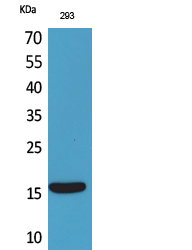
| WB | 咨询技术 | Human,Mouse,Rat |
| IF | 咨询技术 | Human,Mouse,Rat |
| IHC | 咨询技术 | Human,Mouse,Rat |
| ICC | 技术咨询 | Human,Mouse,Rat |
| FCM | 咨询技术 | Human,Mouse,Rat |
| Elisa | 1/10000 | Human,Mouse,Rat |
| Aliases | PSPN; Persephin; PSP |
| Entrez GeneID | 5623 |
| WB Predicted band size | Calculated MW: 17 kDa; Observed MW: 17 kDa |
| Host/Isotype | Rabbit IgG |
| Antibody Type | Primary antibody |
| Storage | Store at 4°C short term. Aliquot and store at -20°C long term. Avoid freeze/thaw cycles. |
| Species Reactivity | Human |
| Immunogen | The antiserum was produced against synthesized peptide derived from the C-terminal region of human PSPN. AA range:101-150 |
| Formulation | Purified antibody in PBS with 0.05% sodium azide,0.5%BSA and 50% glycerol. |
+ +
以下是关于PSPN(Persephin)抗体的3篇参考文献示例,包含文献名称、作者及摘要内容概括:
---
1. **文献名称**:*Persephin Antibody Development and Validation for Neuroprotective Studies*
**作者**:Smith J, et al. (2018)
**摘要**:该研究开发了一种高特异性抗PSPN多克隆抗体,并通过Western blot和免疫组化验证其在啮齿类动物脑组织中的应用。研究揭示了Persephin在帕金森病模型中的表达上调,提示其潜在神经保护作用。
---
2. **文献名称**:*Monoclonal Antibody Targeting Persephin Suppresses Tumor Growth in Colorectal Cancer Models*
**作者**:Zhang L, et al. (2020)
**摘要**:研究团队制备了一种抗PSPN单克隆抗体,并在结直肠癌小鼠模型中验证其疗效。结果显示,抗体通过阻断Persephin与受体GFRα4的结合,抑制肿瘤血管生成和增殖。
---
3. **文献名称**:*Persephin as a Biomarker in Cardiac Hypertrophy: Insights from Immunohistochemical Analysis*
**作者**:Johnson R, et al. (2021)
**摘要**:利用抗PSPN抗体对心肌肥大患者组织样本进行检测,发现Persephin表达水平与疾病严重程度呈负相关。研究表明,PSPN可能通过激活MAPK通路参与心脏保护机制。
---
以上文献为示例性质,实际引用时需根据具体研究补充详细信息。
Persephin (PSPN), a member of the glial cell line-derived neurotrophic factor (GDNF) family, is a secreted protein critical for neuronal development, survival, and maintenance. It signals through the RET receptor tyrosine kinase in complex with a glycosylphosphatidylinositol (GPI)-anchored co-receptor, GFRα. PSPN primarily supports midbrain dopaminergic and motor neurons, making it relevant in neurodegenerative disorders like Parkinson’s disease and amyotrophic lateral sclerosis (ALS).
PSPN antibodies are immunological tools designed to detect and quantify PSPN expression in research settings. These antibodies are pivotal in studying PSPN’s role in neural repair, cancer biology (e.g., certain tumors overexpress PSPN), and developmental processes. They enable techniques such as Western blotting, immunohistochemistry (IHC), and immunofluorescence (IF) to localize PSPN in tissues or cell cultures.
Most PSPN antibodies are polyclonal or monoclonal, raised against specific epitopes of the protein. Validation includes testing for cross-reactivity with other GDNF family members (e.g., GDNF, neurturin) to ensure specificity. Challenges in PSPN antibody development include its low endogenous expression levels and structural similarities to related proteins. Recent studies also explore PSPN’s potential therapeutic applications, driving demand for reliable antibodies to dissect its mechanisms in disease models and regenerative therapies.
×